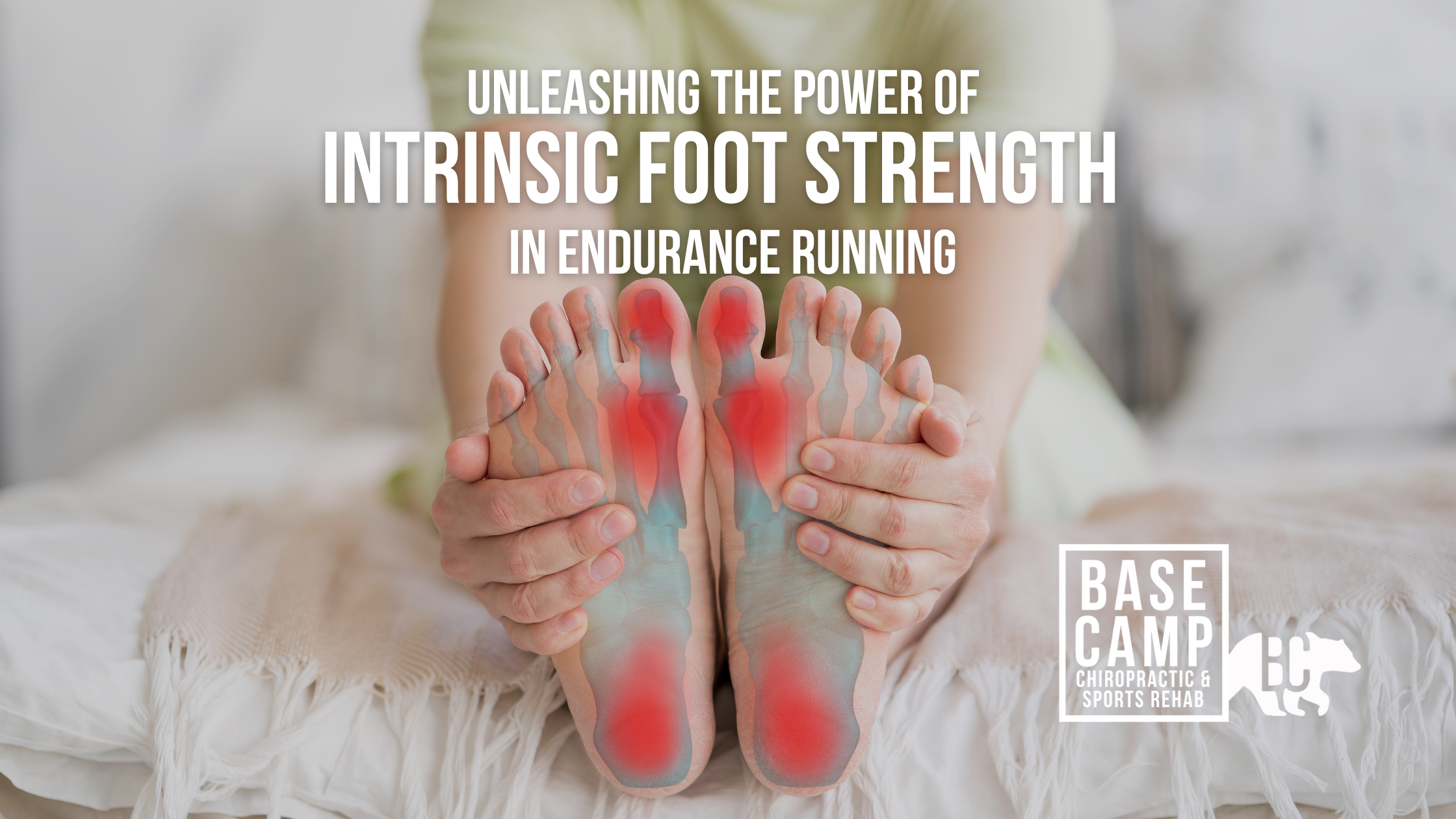
Blog
want to take a crack at your problems from home? Check out our blog posts and find the topics specific to you
Topics:
Downhill Running and Knee Pain
Ever wonder why downhill running always leaves you so much sorer than flat or even uphill running?
Why running downhill makes you sorer than flat or uphill running.
Almost every experienced runner will agree: downhill running leaves you way sorer.
Have you ever wondered why?
There are two typed of soreness that people experience after running. These are muscular soreness and joint soreness.
Muscle Soreness
Muscular soreness is thought to be from damage to the muscle. This damage is microscopic and natural. Your body repairs this type of damage every day. When you are running downhill, your quads, hamstrings, and glutes primarily use a type of contraction called an eccentric contraction. Eccentric contractions are when the muscle is lengthening under resistance. This type of muscle contraction causes more damage than isometric (when the joint doesn’t move) or concentric contraction (when the muscle shortens).
Our muscles are MUCH stronger at eccentric contractions than concentric ones. This is why your legs can handle the force of downhill running, which can reach 7x our body weight in a single step.
This increased force also contributes to more muscle damage, and, you guessed it, more soreness.
Joint Soreness
Joint soreness has a variety of causes but often happens because of cartilage compression due to impact or swelling after activity.
The cartilage in our knees relies on water to absorb the impact of each step. When our cartilage is damaged, the knee’s ability to store water and manage that impact is lessened, and we get more inflammation and swelling.
This can happen because of prolonged and repetitive impact (like ultra running) or shorter, high-impact running (like downhill running).
When it comes to downhill running, we are dealing with much higher forces on the joint, and that can lead to soreness.
What does this mean for you, as a runner?
Neither type of soreness automatically means lasting damage to your muscle or joints, but it is important to respect the healing process. If you are coming off of a long run with a lot of hills, it is a good idea to stick to a flat run or a shorter run.
If you have had knee issues in the past and are looking to get back into running, you need to keep this in mind. It does not mean that you cannot run hills, but it does mean that you should respect the stress that downhill running places on your knees and make sure you are taking the time to recover from them. BOTH of these types of soreness are often delayed a few hours, or even a day or so, after activity, so you won’t even know the impact a run has had on you right away.
This also has important implications for me when I am working with runners who have a history of knee pain. Often we use flat or even mild-grade uphill running during the rehab process. I often have my patients stick to walking the downhill, or avoiding the downhill all together until we have built up the strength and tolerance of the legs and knees to the demands of downhill running.
Author: Dr Mark Murdoch, Chiropractor and Co-Founder at Base Camp Chiropractic and Sports Rehab in Vernon, BC.
Mark Murdoch is a Doctor of Chiropractic with a Master’s Degree in Sports Medicine.
Contact: drmurdoch@basecampclinic.com
Book a free Consult with Dr Murdoch: book here
Instagram: Base.Camp.Doc
Disclaimer: This blog is intended for general informational purposes only and is not intended for the delivery of medical advice. No doctor/patient relationship is formed. The use of information on this blog or materials linked from this blog is at the user's own risk. The content of this blog and website is not intended to be a substitute for medical advice.
How to Run Pain-Free in 2023
Running can cause all sorts of injuries, but there are things you can do to prevent it! Here is how you stay injury free in 2023
5 tips to keep you from being stuck inside because on injuries this year.
1) STRENGTH TRAIN
Strength training has been proven, over and over again, to increase your resilience and decrease your chance of injury. It increases your capacity, while simultaneously making you a faster and more efficient runner.
The easiest way to build a running strength program is to use these exercises in every session:
Calf raise
Deadlift
Squat
If you are new to strength training it can be confusing and intimidating. Join our 12-week Run Strong program for in-person strength coaching specific to runners. Apply for the next group of Run Strong here
2) Listen to your body, and don’t wait until your injury is debilitating to get help
It is way harder to rehab an injury that you have ignored for weeks, months of years. Next time you have a niggle or a hot spot that worries you, get it assessed. We work with a lot of runners. If you are dealing with an injury, book a free consult today. The last thing you want is to be caught in Runners’ Injury Purgatory.
Pain and injury can be incredibly frustrating, and downright depressing.
If you are ready to get out of pain and back to running, we can help.
3) Hydrate
Suprised? Hydration is so important for runners. Being on top of your hydration keeps you fitter and healthier throughout your run, but hydration is about more than that. Being hydrated during your daily life is just as important as hydrating before or during your run.
My recommendation comes from an exercise physiologist named Dr Andy Galpin, who recommends consuming 1 ounce of water for every pound of body weight, divided by 30, every 15 minutes. For example, a 100 lb athlete should consume 3 oz every thirty minutes, while a 150 lb athlete should consume 5 oz and a 200 lb athlete would consume 6.7 oz.
This doesn’t address electrolytes, which is a whole other topic, but in general, make sure you have electrolytes in your hydration if your effort is longer than. 30 minutes. My go-to electrolyte is the LMNT salt packets that you can add to water (available for sale at Base Camp Chiropractic and Sports Rehab)
4) Get enough protein
Protein is literally the building blocks of our body. When we run, we start to break down parts of our body. If we are getting enough protein, we can build those parts of our body back up better than before. But if we are not adequately fueling? Well… you ever tried building a Lego castle without all the pieces? Aim to get 1.6-2 grams of protein for every kilogram of body weight per day, especially on days when you are running. Consider supplementing with a protein shake on your run days.
Protein shakes are a great way to make sure you are meeting your minimums for the day.
5) SLEEP
Sleep is the ultimate performance-enhancing drug. Getting at least 8 hours per night is essential to keep you injury free and make you a better runner. Many active runners should be aiming for 9 hrs of sleep every single night! On top of quantity, quality is also important. Make sure you have a consistent nighttime routine and that you are getting to sleep at the same time every night to maximize your body’s ability to heal and prepare you for the next day.
Try to stay consistent with your bed time too, to maximize your sleep quality.
Author: Dr Mark Murdoch, Chiropractor and Co-Founder at Base Camp Chiropractic and Sports Rehab in Vernon, BC.
Mark Murdoch is a Doctor of Chiropractic with a Master’s Degree in Sports Medicine.
Contact: drmurdoch@basecampclinic.com
Instagram: Base.Camp.Doc
Disclaimer: This blog is intended for general informational purposes only and is not intended for the delivery of medical advice. No doctor/patient relationship is formed. The use of information on this blog or materials linked from this blog is at the user's own risk. The content of this blog and website is not intended to be a substitute for medical advice.
Do I have to stop running?
The reality is that some running injuries do need a period of Relative Rest. This will inevitably mean a change in your running schedule, but it does not mean the complete elimination of your favourite activity.
I treat a lot of runners.
One of the hardest conversations I have with runners is whether or not they need to stop running when they start experiencing pain.
It is really common that runners coming to me tell me that their doctor told them to stop running and that running is the cause of their pain.
SPOILER ALERT: There’s a better way.
Before I get into the nuances of the question “Do I have to stop running if I have [insert painful area here]?” we need to set the stage. When it comes to people walking through the door into my clinic or scheduling online coaching/consulting with me my goal is ALWAYS to help you keep you DOING WHAT YOU LOVE and not take you away from it.
PUBLIC SERVICE ANNOUNCEMENT: You already know that if something hurts to do and you stop doing that thing you will have less pain.
That is not why you need some guidance. You are looking for solutions to keep you doing what you love. Very rarely (in fact, almost NEVER) do I recommend my patients to completely eliminate their favourite activity. In the rare cases that I do, the elimination is TEMPORARY and only if it is absolutely necessary.
The reality is that some running injuries do need a period of Relative Rest. Relative Rest means a period of decreased running volume or intensity. This will inevitably mean a change in your running schedule, but it does not have to mean the complete elimination of your favourite activity.
There are a few considerations when we are considering what to do if you have running-related pain or injury:
How much are you currently running compared to how much you were running 6 weeks ago?
Rapid changes in mileage?
Changes to your routine?
Why are you running in the first place?
Running only for fitness?
Running in preparation for a race?
Running to clear your headspace?
What does ‘relative rest’ mean to you?
Complete elimination of activity?
Alternate activities besides running?
Changing your running volume/terrain/cadence/pace?
If you have been suffering from running-related pain, you already know how frustrating is it. The good news is that IT DOES HEAL. The catch is that it takes direction and a structured recovery program. My goal is to keep you running.
One this is usually certain when it comes to running injuries though… if you keep doing what your are doing the way your are doing it, it won’t get better and it will get worse. Something needs to change.
If you are dealing with a running injury, and have been told you need stop running, but you are ready for another approach, book a consult with us at Base Camp. Learn a better way.
Author: Dr Mark Murdoch, Chiropractor and Co-Founder at Base Camp Chiropractic and Sports Rehab in Vernon, BC.
Mark Murdoch is a Doctor of Chiropractic with a Master’s Degree in Sports Medicine.
Contact: drmurdoch@basecampclinic.com
Instagram: Base.Camp.Doc
Disclaimer: This blog is intended for general informational purposes only and is not intended for the delivery of medical advice. No doctor/patient relationship is formed. The use of information on this blog or materials linked from this blog is at the user's own risk. The content of this blog and website is not intended to be a substitute for medical advice.
Upper Body Training: Exercises Every Runner Should Be Doing - Part 5
EVERY runner should be performing Upper Body Strength Training. Here are the exact exercises I give to many of my running clients and patients.
This is Part 5 of a 6 parts series covering the exercises that Every Runner Should Be Doing.
Missed the First 4 Parts? Find them here
All runners should have 1-2 strength sessions per week if they want to run faster and further while remaining injury-free.
Here are the exercise categories I start all my runners with:
Lower Legs
Hips and Thighs
Core
Compound Movements (integrating the trunk and lower body)
Upper Body Exercises
Foot Strength
This is an area that I tend to get a lot of push back… or at least a lot of blank looks and confused head scratches.
Huh? Upper Body Training for Runners? That seems silly.
Hear me out…
Our body parts do not function in isolation.
Have you ever tried running without using your arms? Go ahead. Try it and then come back to this article.
…
Feels weight right?
That is because our bodies are BUILT to run, and the upper body is no exception. It is part of the reason we have so much less muscle mass in the upper body. Every time you swing your arms, you are preserving energy from your stride. So… if the upper body is involved in running, it is worth training.
You don’t need to aim for Arnold size arms… but you should have adequate pressing and pulling strength to make you more efficient overall.
Some basic upper body strength work
While runners don’t need extensive upper body strength work, adding in some balanced pressing and pulling can be beneficial to your overall athleticism.
Arm to perform each of these exercises at a moderate weight for 8-12 reps one week, and a heavy weight for 3-8 reps on the alternative weeks.
In sum…
In reality, you do not need to be doing THESE exercises. There are literally thousands of exercises you can choose from, these are just the ones that I like to see my patients and clients doing. But you should be doing SOME form of strength training. Both for injury prevention AND to improve your performance.
In general, I recommend some form of:
Lower Leg Specific Training
Hip Specific Training
Core Training (primarily “anti-rotation” or '“anti-movement“ exercises)
Compound Movements emphasizing the Posterior Chain Strength Exercises (glutes and hamstrings)
Basic Upper Body Strength exercises (1-2 pressing and pulling exercises)
Foot Strength
Cover all these bases and you are bound to feel better and run with more confidence
NEXT UP: Part 6 - Foot Strengthening Exercises
Author: Dr Mark Murdoch, Chiropractor and Co-Founder at Base Camp Sport and Spine in Vernon, BC.
Mark Murdoch is a Doctor of Chiropractic with a Master’s Degree in Sports Medicine.
Contact: drmurdoch@basecampclinic.com
Instagram: Base.Camp.Doc
Compound Exercises: Exercises Every Runner Should Be Doing - Part 4
Compound Exercises you should be doing to make you a better runner
This is Part 3 of a 6 parts series covering the exercises that Every Runner Should Be Doing.
Missed the First 3 Parts? Find them here
Part 2: Hip Exercises for Runners
Part 3: Core Training
All runners should have 1-2 strength sessions per week if they want to run faster and further while remaining injury-free.
Here are the exercise categories I start all my runners with:
Lower Legs
Hips and Thighs
Core
Compound Movements (integrating the trunk and lower body)
Upper Body Exercises
Foot Strength
The reason we use Compound Exercises (exercises that require more than one joint to move) is because they help our body learn to coordinate muscles and joints through a larger range of motion. This can help our strength and balance, and enhance the transfer of our training to our running.
compound movements
Running is essentially a series of repetitive single-leg jumps, from one foot to the other, THOUSANDS of times per run. It pays dividends to train what we refer to as the ‘posterior chain’ (which is essentially from the soles of your feet to your back).
If you are paying attention, you may have noticed that some of the exercises in the Hip/Glute post are also compound movements. The exercises below take it a bit further, and challenge you through additional Range of Motion.
Here are some of the compound movements I use for my training and I have my runners use:
Some final points…
In reality, you do not need to be doing THESE exercises. There are literally thousands of exercises you can choose from, these are just the ones that I like to see my patients and clients doing. But you should be doing SOME form of strength training. Both for injury prevention AND to improve your performance.
In general, I recommend some form of:
Lower Leg Specific Training
Hip Specific Training
Core Training (primarily “anti-rotation” or '“anti-movement“ exercises)
Compound Movements emphasizing the Posterior Chain Strength Exercises (glutes and hamstrings)
Basic Upper Body Strength exercises (1-2 pressing and pulling exercises)
Foot Strength
Cover all these bases and you are bound to feel better and run with more confidence
NEXT UP: Part 5 - Upper Body Training
Author: Dr Mark Murdoch, Chiropractor and Co-Founder at Base Camp Sport and Spine in Vernon, BC.
Mark Murdoch is a Doctor of Chiropractic with a Master’s Degree in Sports Medicine.
Contact: drmurdoch@basecampclinic.com
Instagram: Base.Camp.Doc






















How running injuries happen